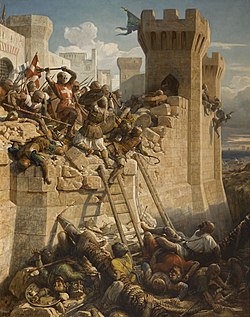The fall of Outremer describes the history of the Kingdom of Jerusalem from the end of the last European Crusade to the Holy Land in 1272 until the final loss in 1302. The kingdom was the center of Outremer—the four Crusader states—formed after the First Crusade in 1099 and reached its peak in 1187. The loss of Jerusalem in that year began the century-long decline. The years 1272–1302 are fraught with many conflicts throughout the Levant as well as the Mediterranean and Western European regions, and many Crusades were proposed to free the Holy Land from Mamluk control. The major players fighting the Muslims included the kings of England and France, the kingdoms of Cyprus and Sicily, the three Military Orders and Mongol Ilkhanate. Traditionally, the end of Western European presence in the Holy Land is identified as their defeat at the Siege of Acre in 1291, but the Christian forces managed to hold on to the small island fortress of Ruad until 1302.
The Holy Land would no longer be the focus of the West even though various crusades were proposed in the early years of the fourteenth century. The Knights Hospitaller would conquer Rhodes from Byzantium, making it the center of their activity for two hundred years. The Knights Templar, the elite fighting force in the kingdom, would be disbanded and its knights imprisoned or executed. The Mongols converted to Islam, but disintegrated as a fighting force. The Mamluk sultanate would continue for another century. The Crusades to liberate Jerusalem and the Holy Land were over.
